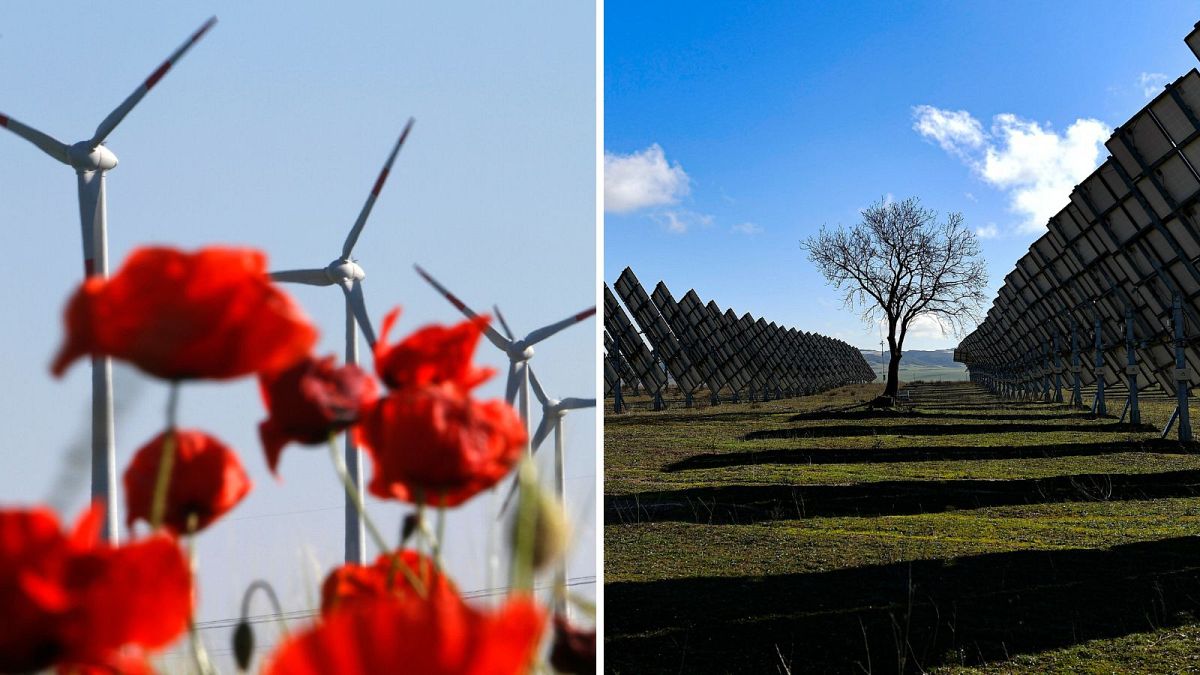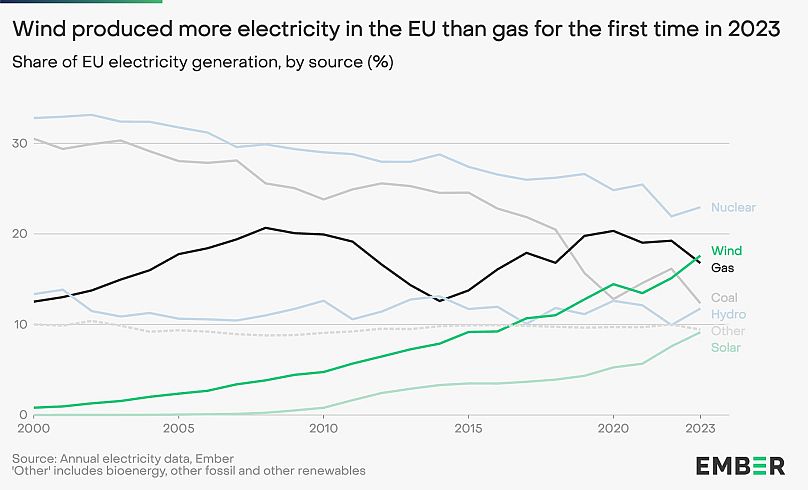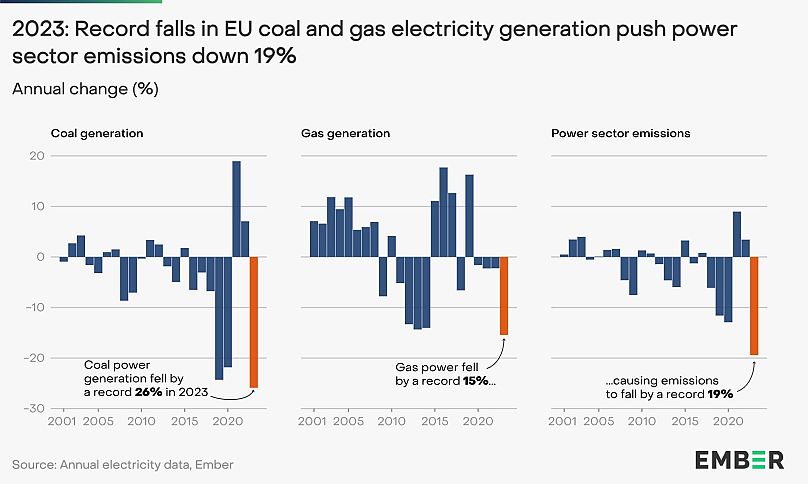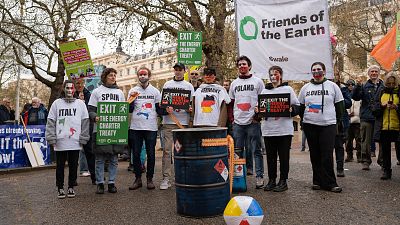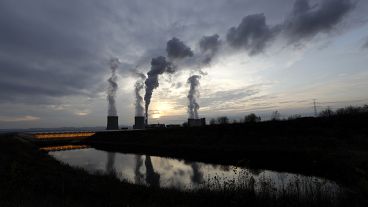Europe’s power demand is expected to rise again soon, as electrification takes off through heat pumps and EVs.
More of Europe’s electricity came from wind power than fossil gas for the first time ever last year.
That’s according to the latest annual review from clean energy think tank Ember, which is peppered with positive statistics about the EU’s energy transition.
Wind and solar produced a record 27 per cent of the bloc’s electricity in 2023 - above a quarter for the first time. Coal and gas took a corresponding nosedive, with the former falling to its lowest ever level at just 12 per cent of the EU’s electricity generation.
“The EU’s power sector is in the middle of a monumental shift,” says Sarah Brown, Ember’s Europe programme director. “Fossil fuels are playing a smaller role than ever as a system with wind and solar as its backbone comes into view.”
Falling electricity demand also contributed to the “unprecedented collapse” in coal and gas generation, according to the analysts, as the energy crisis continues to squeeze demand.
With the news that the EU will be targeting a 90 per cent cut in greenhouse gas emissions by 2040, here’s how renewables are picking up pace.
How did the EU’s electricity mix change in 2023?
Wind generation grew by 13 per cent to reach 18 per cent of the EU’s power mix last year - or 475 TWh, roughly the size of France’s total electricity demand.
It overtook gas which provided 17 per cent. While solar generated 9 per cent of EU electricity.
Overall, renewables rose to a record 44 per cent share of EU power in 2023, as hydro power also recovered from lows in 2022.
Which country is leading this wind revolution? It depends on your metric, but there’s a few up top with 58 per cent of Denmark’s electricity coming from turbines; Germany generating the highest amount of wind power at 141 TWh; and Sweden producing the most per capita.
Germany also saw the largest increase in wind generation, followed by France and the Netherlands.
“The EU led a big push last year at COP28 to commit the world to phase out fossil fuels,” notes Pieter de Pous, Programme Leader at the E3G think tank. “These 2023 power market data show this wasn’t just talk with the EU making very significant progress at home in moving to a fossil free power system with cheap renewables eliminating demand for coal and gas, permanently.”
Coal generation fell by a record 26 per cent in 2023. This decline did not lead to a rise in gas, which also fell by 15 per cent - the largest annual reduction since at least 1990.
Why did the EU’s electricity demand drop in 2023?
Renewables can’t take all the credit, as the EU’s electricity demand dropped by 3.4 per cent in 2023 compared to 2022, and 6.4 per cent compared to 2021 levels when the energy crisis began.
Ember links just over a third (3.8 per cent) of this longer-term drop to a fall in industrial electricity consumption. In particular, energy-intensive sectors like iron and steel, chemicals and paper were likely hit by higher gas prices.
Mild weather and energy savings and efficiency also contributed to less electricity being needed - although electrification created more demand.
Our swiftly electrifying lives can be seen in the three million heat pumps and three million electric cars sold in the EU since 2021. Combined with 500 MW of electrolysers, this green tech surge has added an estimated 1.3 per cent to the EU’s overall electricity demand in the last couple of years.
“As electrification takes off through more heat pumps, electric vehicles and electrolysers, the EU will enter a new era of rising electricity demand,” says Ember’s global insights director Dave Jones. “Renewables will need to keep pace with that demand increase in order to deliver the emissions cuts needed for a safe climate.”
Interestingly, while the energy crisis reduced electricity demand in almost every country last year - Slovakia and Romania especially - Ireland, Cyprus and Portugal actually recorded rises.
In Ireland, much of this rise was driven by data centres, which consumed a whopping 18 per cent of the country’s electricity in 2022, a 400 per cent rise from 2015 according to official data.
EU still needs to scale up wind and solar to reach climate targets
While there’s much to celebrate in the new review, energy experts warn that this transition still has a considerable way to go.
“The energy crisis and Russia’s invasion of Ukraine did not lead to coal and gas resurgence - far from it. Coal is nearing phase-out, and as wind and solar grow, gas will be next to enter terminal decline,” says Ember’s Brown. “However, it is not time to get complacent. The EU needs a laser focus on rapidly deploying wind, solar and flexibility to create a system free of fossil fuels’ risks.”
The bloc’s REPowerEU plan to stay under 1.5C of global heating depends on 55 per cent of electricity coming from wind and solar by 2030. That’s nearly double where we are now at 27 per cent from the two key renewables.
Though solar generation rose last year, its year-on-year growth was 25 per cent lower than in 2022. Wind is also off track of the 15 per cent it needs to increase every year until the end of 2030, within an inconsistent decade.
“While some countries are racing to deploy more wind and solar as a social and economic opportunity, others, particularly in Central and Eastern Europe, are lagging and stand to miss out,” comments Martin Hojsík MEP, Vice President of European Parliament (Renew Europe, Progressive Slovakia).
He adds that Europe must switch to clean power to “shield itself” from security risks related to imported fossil fuels - as well as to reap the benefits of the energy transition.
It’s not just renewables themselves that need to be rolled out faster to get there, but ‘system-wide enablers’ such as grids and energy storage.
Will the new 2040 climate target speed up the EU’s renewable journey?
In order to reach climate neutrality by 2050, the European Commission has this week announced a new target of slashing greenhouse gas emissions 90 per cent by 2040.
This new goal is still subject to debate by EU lawmakers, and won’t become legally binding until after European Parliament elections in June when a new Commission is formed.
But renewable energy experts have welcomed the “ambitious” signal from Brussels.
“A target of -90 per cent paves the way for decisive action to decarbonise our power sector - the first, crucial step on the way to net zero. It should be clear from this that there’s no further time to waste on building more fossil fuel infrastructure,” says Elisabeth Cremona, energy and climate data analyst at Ember.
“An ambitious target helps establish a clear direction of travel away from fossil fuels, particularly in unlocking all the supportive infrastructure that will enable rapid renewables rollout and clean electrification.”
Walburga Hemetsberger, CEO of SolarPower Europe says the solar sector “wholeheartedly support” the 90 per cent emissions cut scenario.
“We hope to see this message carry through in a dedicated Electrification Act,” she adds. “Importantly, the proposal also considers the investment agenda, which recognises the need for scaling up private and public funding such as the Innovation Fund, and the end of fossil fuels subsidies.”
Climate justice groups are less impressed, however. Friends of the Earth Europe, for example, says the proposed emissions cuts fall short of the EU’s historical obligation to achieve ‘real zero emissions’ long before 2050.
“There is a dark hole where an end to fossil fuels should be. Europe must define an expiry date for its fossil fuel addiction - long before 2050 - and stop pleasing the fossil fuel industry with dangerous loopholes and dodges like CCS [carbon capture storgae].”
